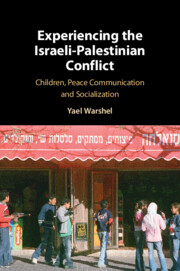Book contents
- Experiencing the Israeli-Palestinian Conflict
- Experiencing the Israeli-Palestinian Conflict
- Copyright page
- Dedication
- Contents
- Figures
- Tables
- Acknowledgments
- Note on the Text
- Abbreviations
- Introduction
- Part I The Encoding and Production of Israeli and Palestinian Sesame Street
- Part II Audience Reception of Israeli and Palestinian Sesame Street
- Introduction to Part II: Audience Reception Methodologies
- 4 Decodings by Palestinians-in-the-Making
- 5 Decodings by Jewish Israelis-in-the-Making
- 6 Decodings by Arab/Palestinian Israelis-in-the-Making
- Conclusion to Part II: The Utility of the Series for All Three Partners to the Conflict?
- Part III Situating the Reception of Israeli and Palestinian Sesame Street in Mundane, Intractable Conflict Zone Practices
- Part IV Conclusions and Recommendations to Improve Peace Communication Research, (Evidence-Based) Practice and Conflict Intractability Interpretation
- Book part
- References
- Index
- Plate Section (PDF Only)
5 - Decodings by Jewish Israelis-in-the-Making
from Part II - Audience Reception of Israeli and Palestinian Sesame Street
Published online by Cambridge University Press: 08 July 2021
- Experiencing the Israeli-Palestinian Conflict
- Experiencing the Israeli-Palestinian Conflict
- Copyright page
- Dedication
- Contents
- Figures
- Tables
- Acknowledgments
- Note on the Text
- Abbreviations
- Introduction
- Part I The Encoding and Production of Israeli and Palestinian Sesame Street
- Part II Audience Reception of Israeli and Palestinian Sesame Street
- Introduction to Part II: Audience Reception Methodologies
- 4 Decodings by Palestinians-in-the-Making
- 5 Decodings by Jewish Israelis-in-the-Making
- 6 Decodings by Arab/Palestinian Israelis-in-the-Making
- Conclusion to Part II: The Utility of the Series for All Three Partners to the Conflict?
- Part III Situating the Reception of Israeli and Palestinian Sesame Street in Mundane, Intractable Conflict Zone Practices
- Part IV Conclusions and Recommendations to Improve Peace Communication Research, (Evidence-Based) Practice and Conflict Intractability Interpretation
- Book part
- References
- Index
- Plate Section (PDF Only)
Summary
For the state-bearing nation audience, Palestinian characters were absent from the series, only 25% of those who responded clearly seeing them. Chapter 5 describes how these Jewish Israeli children from Alfei Menashe argued that since Palestinians are “terrorists,” the “Israeli” producers, Jewish Israelis just like they are, would not have allowed them onto Sesame Street to harm them. They used production-based conventions to reinterpret what they perceived as the imbalance of encoded characters who were both “good people” and their partners to conflict. The majority converted both the national and civic identity of Palestinian characters: 80 percent transformed them into Jewish Israelis, or simply “Israelis”; 25 percent into Arab/Palestinian Israelis. 56% decoded their shared others, Arab/Palestinian Israeli characters. These children interpreted all the characters as “good people,” whether defined as Jewish Israeli, Arab/Palestinian Israeli or Palestinian, though none generalized their mediated experiences about their other out-grouping, or Palestinians, to additional characters and real-world scenarios. Where their shared other was concerned, Arab/Palestinian-Israelis, only a minority generalized those experiences, such that at least regarding their shared other, the series could potentially move this audience attitudes, which otherwise ranged from negative to neutral.
Keywords
- Type
- Chapter
- Information
- Experiencing the Israeli-Palestinian ConflictChildren, Peace Communication and Socialization, pp. 178 - 198Publisher: Cambridge University PressPrint publication year: 2021

